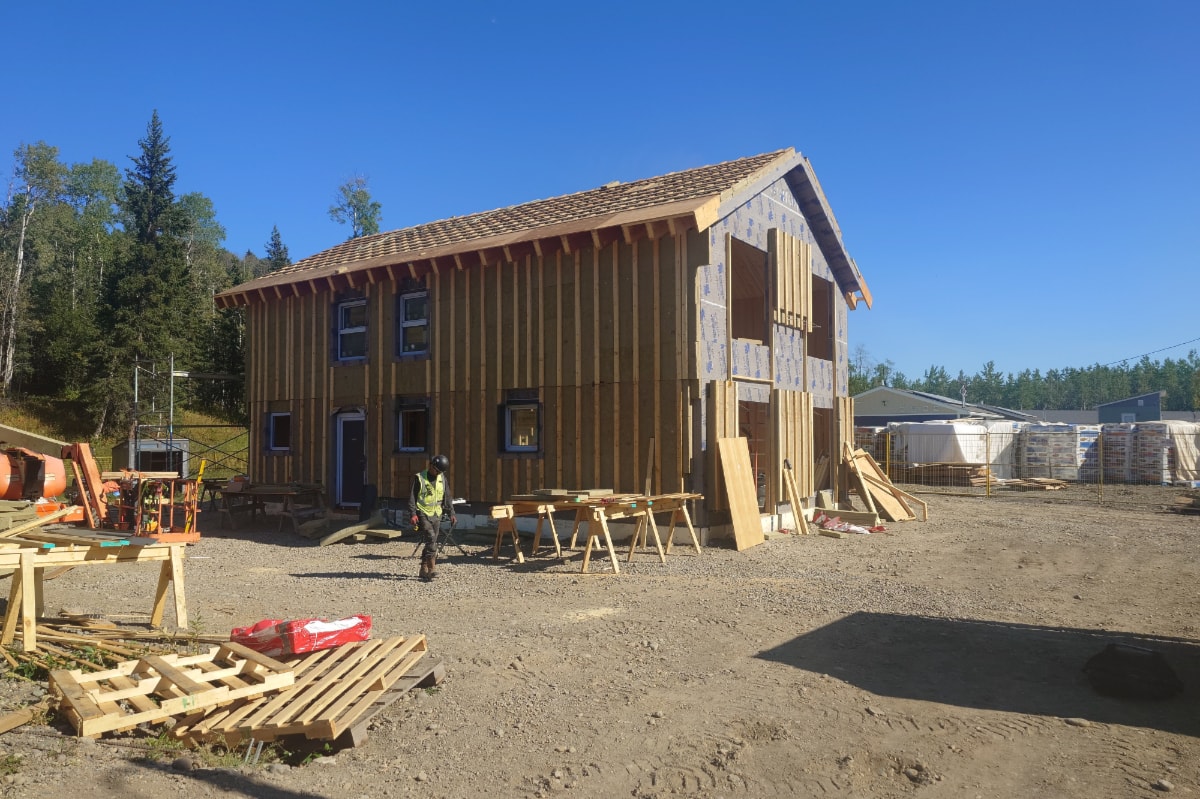
When Nak’azdli Development Corp. (NDC) unveils its inaugural Timber House later this month — a unique prefabricated home in Canada that uses stud lumber from local saw mills and an innovative panel construction system by local forestry startup Deadwood Innovations — visitors will see firsthand what’s possible when academia partners with business to solve pressing challenges.
The new home-building system could be a salve to Canada’s housing crisis in remote communities, while mitigating challenges faced by the forestry industry.
“There has been a lot of emphasis recently on fast-tracking mass timber construction for large-scale buildings in large urban centres, but very little focus on supporting regional housing, tailored to the specific needs of remote and rural communities,” said Owen Miller, Deadwood Innovations CEO and co-founder, explaining that these large projects primarily use high-cost dimension lumber.
“Our approach is all about tapping into local lumber, resources and expertise to build housing that aligns with community and cultural needs, is sustainable and delivers affordable homes built to last,” Miller said. “The strategic objective is to establish an industrialized housing regional production cluster in one of Canada’s largest forestry corridors.”
The idea came from an earlier development project involving NDC and Deadwood Solutions, which aims to commercialize an upgraded lumber product made from low-value timber and forest residue. The partners developed a thermochemical process that takes aspen and other low-quality timber suitable for sawmilling and transforms it into a durable, high-quality timber.
They quickly identified the need for a more affordable housing solution in northern B.C., as well as the opportunity to develop a local lumber supply chain that could support a local prefabricated housing model.
To advance both projects, the partners are utilizing the expertise found at the University of Northern British Columbia’s (UNBC) Wood Innovation Research Lab, through a program coordinated by Mitacs, a Canadian innovation organization that helps boost homegrown innovation.
“Housing demand across Canada is real and no matter where you live, everyone is looking for solutions,” said NDC CEO JP Wenger. “This Mitacs-supported research is allowing us to check all boxes when it comes to providing affordable, sustainable housing.”
The model Timber House, expected to be finished later this month, is a first-of-its-kind prefabricated home designed and built by local residents for local residents within the Nak’azdli Whut’en community.
What sets it apart from other prefabricated housing systems is that instead of using primarily high-quality dimension lumber, it relies on simple and economical nail-laminated timber made primarily from stud lumber produced by local sawmills.
The resulting mass timber floor, wall and roof panels – produced locally at the Deadwood Innovations Lumber Upgrader Pilot Plant in Fort St. James using a novel panel construction system – are both durable and warm. Once completed, the housing kit is delivered on site and erected by crane in just a couple of days.
“The idea is to speed construction timelines and improve quality by pre-building the panels over the winter in a controlled facility away from harsh weather and then assembling the homes in summer,” said Wenger. “Traditionally, a company like Nak’azdli Construction could only build a few houses per year because they start from scratch in the spring or summer. Our process will allow us to double or triple that timeline.”
“We’re taking a tree from the local territory, bringing it to a local mill, having it milled and taking that product to our facility to create panels, and then erecting a house in our territory,” he added.
Mitacs-supported researcher Yuming Bai, a former architect from China who is pursuing his Master of Applied Science in Engineering at UNBC, is currently working on an advanced computational design tool to speed the prefabrication design and construction process. By applying algorithms and parametrical tools, he is creating a software plug-in for 3D modelling systems that will automatically generate precise drawings from architectural floor plans and section plans, while meeting building code regulations and other engineering specifications.
“My work is about optimizing the engineering design phase, which in turn will shorten the overall construction time,” said Bai, who was drawn to Canada for its wood construction expertise.
According to UNBC associate professor in wood engineering Jianhui Zhou, one of the biggest barriers facing smaller companies that want to get into the prefabricated housing market is a lack of designers who understand the complex design process. The idea is to simplify the process through digital automation, resulting in shop drawings that can go straight to production.
“With this demonstration project, we’re showing that our housing kits are feasible, doable and economical, that prefabrication is better for our harsh remote climate and gives us more control over quality, time and cost, and that the end-product is built to last,” said Zhou. “We’re also breathing new life into local sawmills that are currently facing the risk of closure. Our solution puts local people first.”



